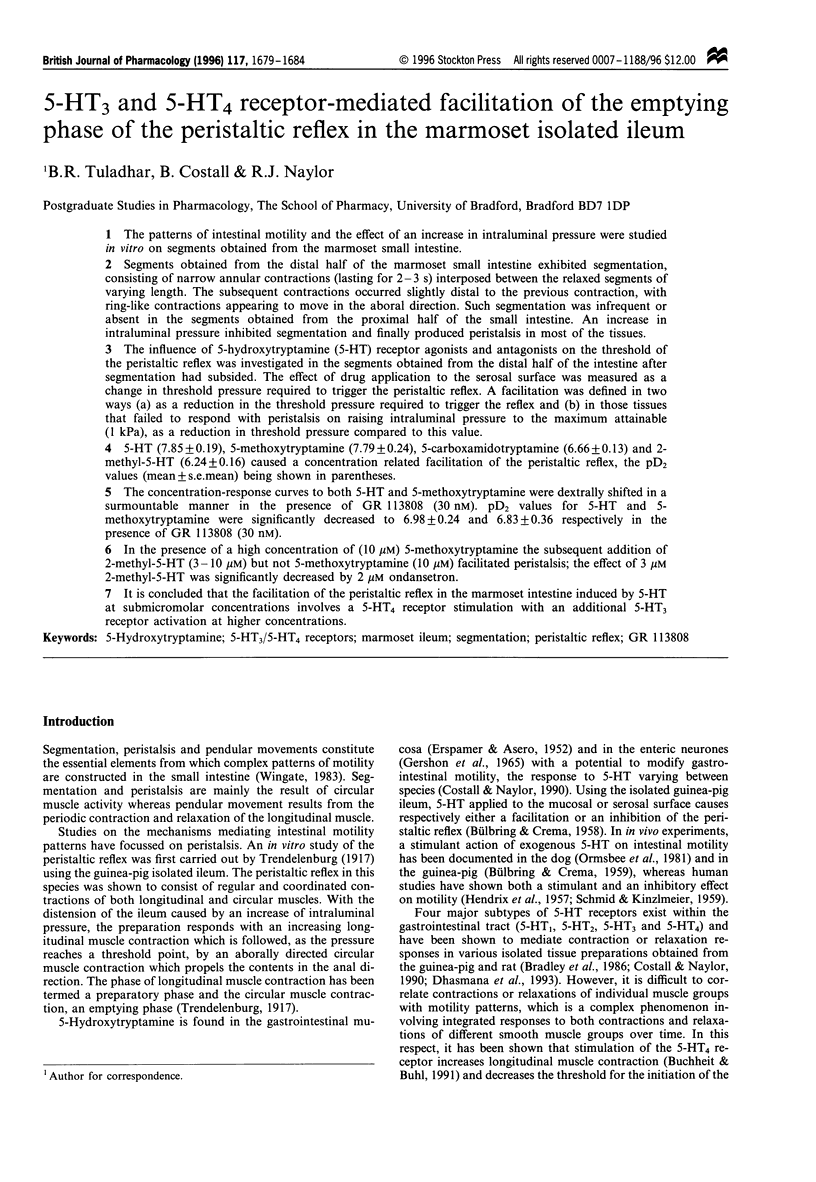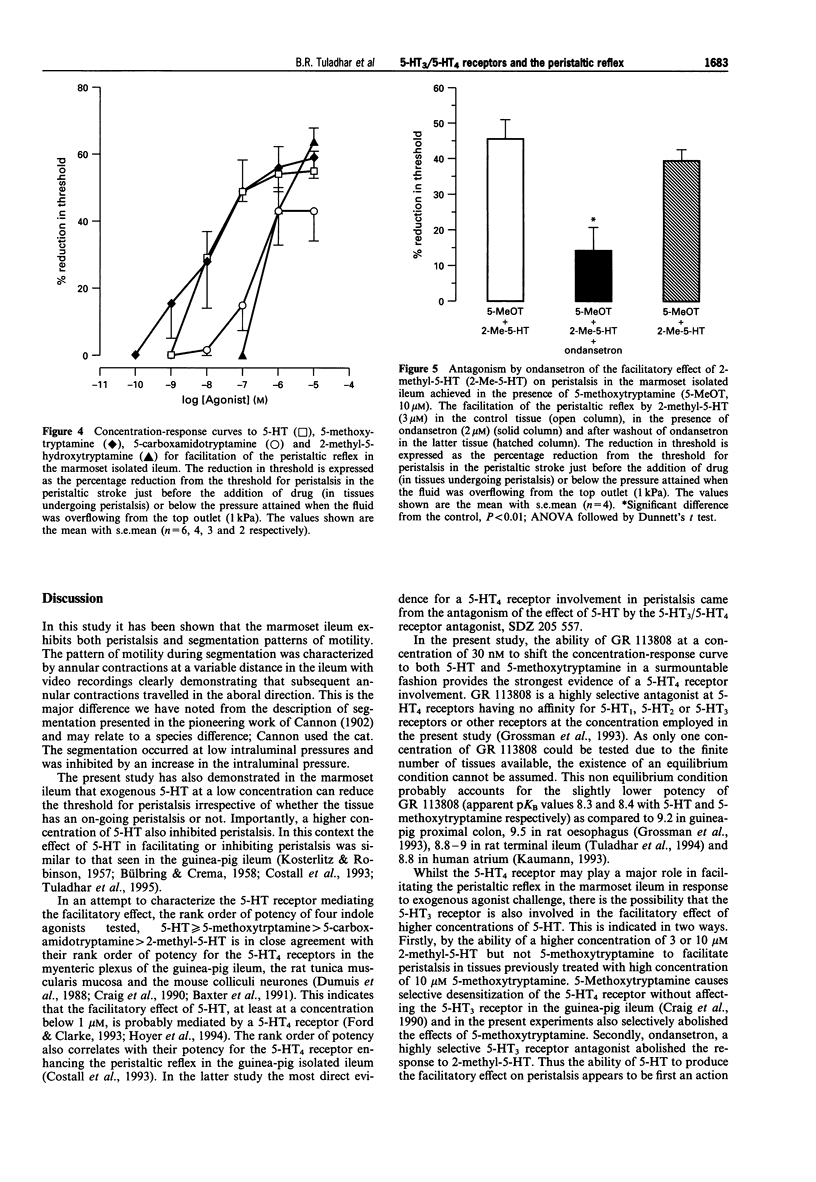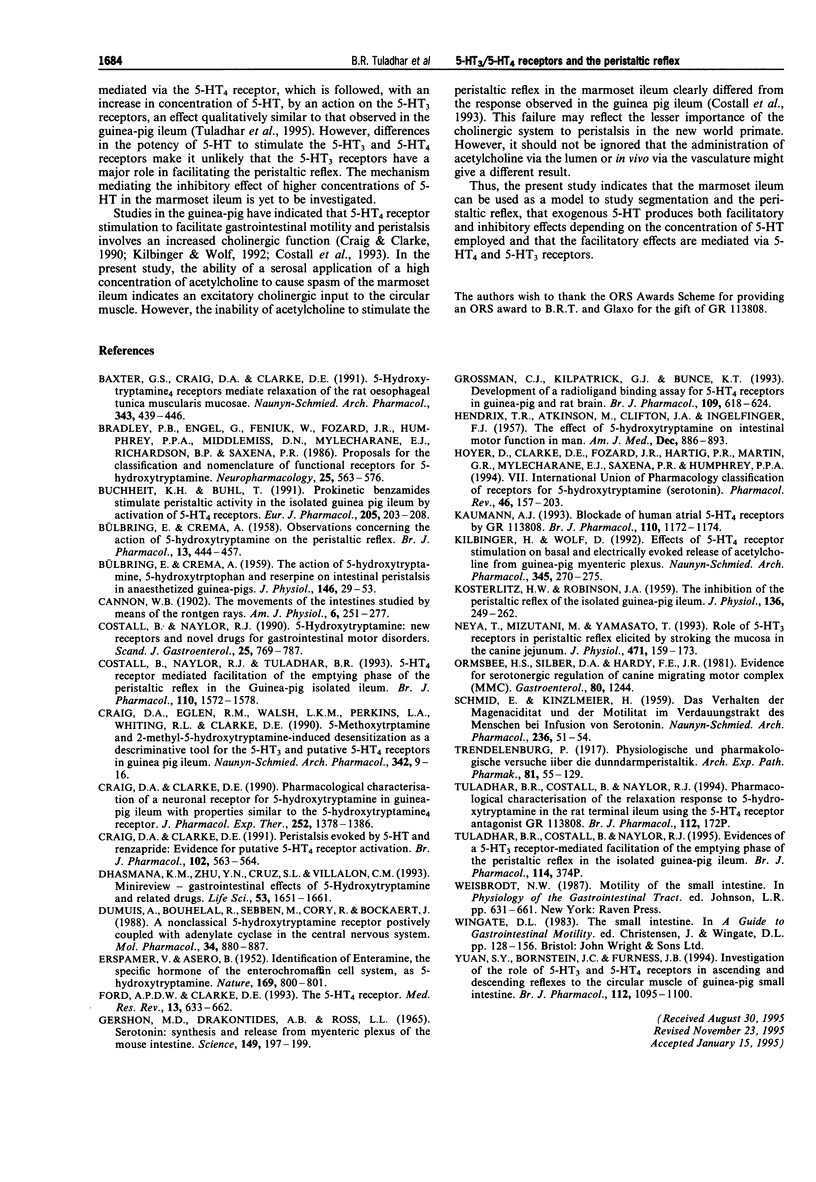Abstract
1. The patterns of intestinal motility and the effect of an increase in intraluminal pressure were studied in vitro on segments obtained from the marmoset small intestine. 2. Segments obtained from the distal half of the marmoset small intestine exhibited segmentation, consisting of narrow annular contractions (lasting for 2-3 s) interposed between the relaxed segments of varying length. The subsequent contractions occurred slightly distal to the previous contraction, with ring-like contractions appearing to move in the aboral direction. Such segmentation was infrequent or absent in the segments obtained from the proximal half of the small intestine. An increase in intraluminal pressure inhibited segmentation and finally produced peristalsis in most of the tissues. 3. The influence of 5-hydroxytryptamine (5-HT) receptor agonists and antagonists on the threshold of the peristaltic reflex was investigated in the segments obtained from the distal half of the intestine after segmentation had subsided. The effect of drug application to the serosal surface was measured as a change in threshold pressure required to trigger the peristaltic reflex. A facilitation was defined in two ways (a) as a reduction in the threshold pressure required to trigger the reflex and (b) in those tissues that failed to respond with peristalsis on raising intraluminal pressure to the maximum attainable (1 kPa), as a reduction in threshold pressure compared to this value. 4. 5-HT (7.85 +/- 0.19), 5-methoxytryptamine (7.79 +/- 0.24), 5-carboxamidotryptamine (6.66 +/- 0.13) and 2-methyl-5-HT (6.24 +/- 0.16) caused a concentration related facilitation of the peristaltic reflex, the pD2 values (mean +/- s.e.mean) being shown in parentheses. 5. The concentration-response curves to both 5-HT and 5-methoxytryptamine were dextrally shifted in a surmountable manner in the presence of GR 113808 (30 nM). pD2 values for 5-HT and 5-methoxytryptamine were significantly decreased to 6.98 +/- 0.24 and 6.83 +/- 0.36 respectively in the presence of GR 113808 (30 nM). 6. In the presence of a high concentration of (10 microM) 5-methoxytryptamine the subsequent addition of 2-methyl-5-HT (3-10 microM) but not 5-methoxytryptamine (10 microM) facilitated peristalsis; the effect of 3 microM 2-methyl-5-HT was significantly decreased by 2 microM ondansetron. 7. It is concluded that the facilitation of the peristaltic reflex in the marmoset intestine induced by 5-HT at submicromolar concentrations involves a 5-HT4 receptor stimulation with an additional 5-HT3 receptor activation at higher concentrations.
Full text
PDF





Selected References
These references are in PubMed. This may not be the complete list of references from this article.
- BULBRING E., CREMA A. Observations concerning the action of 5-hydroxytryptamine on the peristaltic reflex. Br J Pharmacol Chemother. 1958 Dec;13(4):444–457. doi: 10.1111/j.1476-5381.1958.tb00236.x. [DOI] [PMC free article] [PubMed] [Google Scholar]
- BULBRING E., CREMA A. The action of 5-hydroxytryptamine, 5-hydroxytryptophan and reserpine on intestinal peristalsis in anaesthetized guinea-pigs. J Physiol. 1959 Apr 23;146(1):29–53. doi: 10.1113/jphysiol.1959.sp006176. [DOI] [PMC free article] [PubMed] [Google Scholar]
- Baxter G. S., Craig D. A., Clarke D. E. 5-Hydroxytryptamine4 receptors mediate relaxation of the rat oesophageal tunica muscularis mucosae. Naunyn Schmiedebergs Arch Pharmacol. 1991 May;343(5):439–446. doi: 10.1007/BF00169544. [DOI] [PubMed] [Google Scholar]
- Bradley P. B., Engel G., Feniuk W., Fozard J. R., Humphrey P. P., Middlemiss D. N., Mylecharane E. J., Richardson B. P., Saxena P. R. Proposals for the classification and nomenclature of functional receptors for 5-hydroxytryptamine. Neuropharmacology. 1986 Jun;25(6):563–576. doi: 10.1016/0028-3908(86)90207-8. [DOI] [PubMed] [Google Scholar]
- Buchheit K. H., Buhl T. Prokinetic benzamides stimulate peristaltic activity in the isolated guinea pig ileum by activation of 5-HT4 receptors. Eur J Pharmacol. 1991 Nov 26;205(2):203–208. doi: 10.1016/0014-2999(91)90821-7. [DOI] [PubMed] [Google Scholar]
- Costall B., Naylor R. J. 5-Hydroxytryptamine: new receptors and novel drugs for gastrointestinal motor disorders. Scand J Gastroenterol. 1990 Aug;25(8):769–787. doi: 10.3109/00365529008999215. [DOI] [PubMed] [Google Scholar]
- Costall B., Naylor R. J., Tuladhar B. R. 5-HT4 receptor mediated facilitation of the emptying phase of the peristaltic reflex in the guinea-pig isolated ileum. Br J Pharmacol. 1993 Dec;110(4):1572–1578. doi: 10.1111/j.1476-5381.1993.tb14003.x. [DOI] [PMC free article] [PubMed] [Google Scholar]
- Craig D. A., Clarke D. E. Peristalsis evoked by 5-HT and renzapride: evidence for putative 5-HT4 receptor activation. Br J Pharmacol. 1991 Mar;102(3):563–564. doi: 10.1111/j.1476-5381.1991.tb12211.x. [DOI] [PMC free article] [PubMed] [Google Scholar]
- Craig D. A., Clarke D. E. Pharmacological characterization of a neuronal receptor for 5-hydroxytryptamine in guinea pig ileum with properties similar to the 5-hydroxytryptamine receptor. J Pharmacol Exp Ther. 1990 Mar;252(3):1378–1386. [PubMed] [Google Scholar]
- Craig D. A., Eglen R. M., Walsh L. K., Perkins L. A., Whiting R. L., Clarke D. E. 5-Methoxytryptamine and 2-methyl-5-hydroxytryptamine-induced desensitization as a discriminative tool for the 5-HT3 and putative 5-HT4 receptors in guinea pig ileum. Naunyn Schmiedebergs Arch Pharmacol. 1990 Jul;342(1):9–16. doi: 10.1007/BF00178965. [DOI] [PubMed] [Google Scholar]
- Dhasmana K. M., Zhu Y. N., Cruz S. L., Villalón C. M. Gastrointestinal effects of 5-hydroxytryptamine and related drugs. Life Sci. 1993;53(22):1651–1661. doi: 10.1016/0024-3205(93)90202-e. [DOI] [PubMed] [Google Scholar]
- Dumuis A., Bouhelal R., Sebben M., Cory R., Bockaert J. A nonclassical 5-hydroxytryptamine receptor positively coupled with adenylate cyclase in the central nervous system. Mol Pharmacol. 1988 Dec;34(6):880–887. [PubMed] [Google Scholar]
- ERSPAMER V., ASERO B. Identification of enteramine, the specific hormone of the enterochromaffin cell system, as 5-hydroxytryptamine. Nature. 1952 May 10;169(4306):800–801. doi: 10.1038/169800b0. [DOI] [PubMed] [Google Scholar]
- Ford A. P., Clarke D. E. The 5-HT4 receptor. Med Res Rev. 1993 Nov;13(6):633–662. doi: 10.1002/med.2610130603. [DOI] [PubMed] [Google Scholar]
- GERSHON M. D., DRAKONTIDES A. B., ROSS L. L. SEROTONIN: SYNTHESIS AND RELEASE FROM THE MYENTERIC PLEXUS OF THE MOUSE INTESTINE. Science. 1965 Jul 9;149(3680):197–199. doi: 10.1126/science.149.3680.197. [DOI] [PubMed] [Google Scholar]
- Grossman C. J., Kilpatrick G. J., Bunce K. T. Development of a radioligand binding assay for 5-HT4 receptors in guinea-pig and rat brain. Br J Pharmacol. 1993 Jul;109(3):618–624. doi: 10.1111/j.1476-5381.1993.tb13617.x. [DOI] [PMC free article] [PubMed] [Google Scholar]
- HENDRIX T. R., ATKINSON M., CLIFTON J. A., INGELFINGER F. J. The effect of 5-hydroxytryptamine on intestinal motor function in man. Am J Med. 1957 Dec;23(6):886–893. doi: 10.1016/0002-9343(57)90298-x. [DOI] [PubMed] [Google Scholar]
- Hoyer D., Clarke D. E., Fozard J. R., Hartig P. R., Martin G. R., Mylecharane E. J., Saxena P. R., Humphrey P. P. International Union of Pharmacology classification of receptors for 5-hydroxytryptamine (Serotonin). Pharmacol Rev. 1994 Jun;46(2):157–203. [PubMed] [Google Scholar]
- KOSTERLITZ H. W., ROBINSON J. A. Inhibition of the peristaltic reflex of the isolated guinea-pig ileum. J Physiol. 1957 Apr 30;136(2):249–262. doi: 10.1113/jphysiol.1957.sp005757. [DOI] [PMC free article] [PubMed] [Google Scholar]
- Kaumann A. J. Blockade of human atrial 5-HT4 receptors by GR 113808. Br J Pharmacol. 1993 Nov;110(3):1172–1174. doi: 10.1111/j.1476-5381.1993.tb13937.x. [DOI] [PMC free article] [PubMed] [Google Scholar]
- Kilbinger H., Wolf D. Effects of 5-HT4 receptor stimulation on basal and electrically evoked release of acetylcholine from guinea-pig myenteric plexus. Naunyn Schmiedebergs Arch Pharmacol. 1992 Mar;345(3):270–275. doi: 10.1007/BF00168686. [DOI] [PubMed] [Google Scholar]
- Neya T., Mizutani M., Yamasato T. Role of 5-HT3 receptors in peristaltic reflex elicited by stroking the mucosa in the canine jejunum. J Physiol. 1993 Nov;471:159–173. doi: 10.1113/jphysiol.1993.sp019895. [DOI] [PMC free article] [PubMed] [Google Scholar]
- Yuan S. Y., Bornstein J. C., Furness J. B. Investigation of the role of 5-HT3 and 5-HT4 receptors in ascending and descending reflexes to the circular muscle of guinea-pig small intestine. Br J Pharmacol. 1994 Aug;112(4):1095–1100. doi: 10.1111/j.1476-5381.1994.tb13196.x. [DOI] [PMC free article] [PubMed] [Google Scholar]


